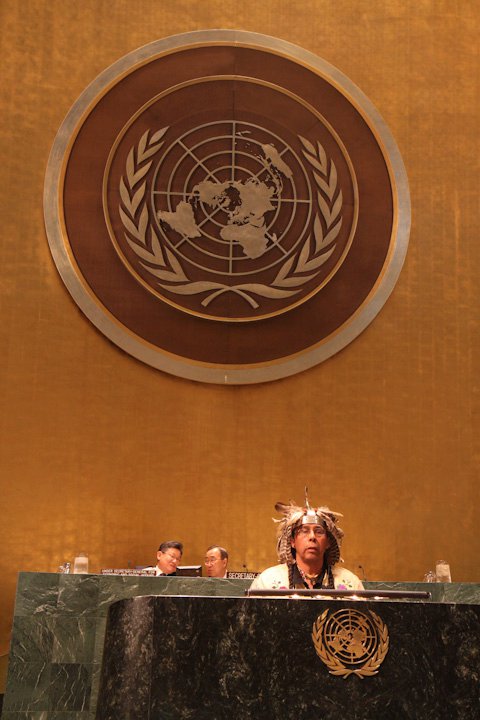ACTION ALERT: Halt oil and gas devastation for Mandan, Hidatsa and Arikara

CALL FORT BERTHOLD BIA and oppose the finding of 'no significant impact' on the plan for 3,000 oil and gas wells here over the next five years. Call Mr. Earl Silk, Fort Berthold BIA 701-627-4707, tell him the lands of the Mandan, Hidatsa and Arikara, Three Affiliated Tribes, are already being destroyed by oil and gas drilling.
Fort Berthold Reservation to Provide Backdrop for International Discussion on Energy and Climate Change
Alyce Spotted Bear joined Fort Berthold Reservation community organizers this week for final planning meetings on a national energy and climate change gathering scheduled late July in North Dakota. The group made plans while hundreds of semi-trucks zoomed across cracked and crumbled roads, shuttling oil and water to and from nearly 400 producing oil wells within reservation boundaries.
“The Protecting Mother Earth Gathering at the Mandan, Hidatsa, and Arikara Nation is very timely relative to the monstrous industrialization of our natural resources, including our oil and gas, coal, and water,” said Spotted Bear, Fort Berthold Community College vice president of Native American Studies. “Our people need a forum in which to objectively articulate their struggles and concerns related to the destruction of our environment. Our air is being dirtied; our natural springs, creeks, lakes, and rivers are being contaminated.”
The Fort Berthold Reservation sits atop the Bakken Formation, the largest discovered contiguous oil field in U.S. history making it the busiest oil field today in the country. Lake Sakakawea, the Great Plains, oil pumps and natural gas flares will provide a backdrop for the 16th annual Protecting Mother Earth Gathering, an event led by the Indigenous Environmental Network, a non-profit environmental and economic justice organization. The four-day gathering titled, “Water, Energy, Climate and the Importance of Health and Culture,” is scheduled July 28-31 at the Little Shell Antelope Society Arbor in New Town, N.D.
About 1,000 people from across the United States are expected to attend. Panelists are set to discuss updates on national and international climate policy, green economy and Native peoples, energy and climate justice, traditional knowledge and cultural survival and the United Nations Declaration on the Rights of Indigenous Peoples. Participants are also invited to entertainment and cultural activities, such as tours, talent shows, sweat lodges, singing and dancing hosted by Three Affiliated Tribe citizens.
Mandan, Hidatsa and Arikara community members became concerned about the local environment soon after Big Oil opened the throttle on oil reserves on the Bakken Formation, an oil rich geologic formation expanding into Montana, Canada and North Dakota. Individual trust land owners first signed oil leases nearly five years ago. Today, more than 350 producing oil wells dot the reservation landscape. “You don’t need to take a toxic tour of the reservation,” said Kandi Mossett, IEN tribal climate change coordinator. “You can see it when you just drive onto Fort Berthold. They’ll see the trucks and the gas flares. You can see the glare off the clouds at night for miles.”
Oil companies arrived on the reservation armed with hydraulic fracturing technology, a drilling method that allows oil companies to tap hydrocarbons long locked in shale and coalbed seams. The process uses sand, chemicals and water to blast and siphon oil from tight rock formations. The oil is then pumped to storage tanks. The technology, also known as “fracking,” has sparked a drilling frenzy across the country. In 2007, there were 449,000 gas wells in 32 states with 32,000 new wells expected to be drilled per year by 2012.
Lyle Gwin, tribal response program coordinator for the Three Affiliated Tribes, said between 1,600 to 3,000 wells are expected to be drilled in the Mandaree segment alone within the next year. The TAT Environmental Division has been monitoring water and air quality for the last nine years. They are still waiting for the EPA to establish a baseline for water quality. The tribe was told that the EPA “never had the manpower to enter the data,” Gwin said.
Data deficiencies have left tribal citizens concerned about the future quality of air and water. “Years ago, when drilling issues first started popping up related to oil, people wanted more community meetings,” said Mossett. “There have been pipeline blowouts, spills and leaks. Lots of people want to do something.”
As fracking popularity rises, so do complaints by ranchers, homeowners as well as small towns and big cities about groundwater contamination. The cauldron of objections, grievances and protests continues to spread across the United States, ranging from the Eastern seaboard to the Rocky Mountains to the Southwest. The question: Are fracturing fluids, man-made and naturally occurring, migrating?
Fracking was first used commercially in 1949 and is now “essential to economic production of oil and gas and commonly used throughout Texas, the United States, and the world,” says Robert Beck in the Washburn Law Journal. Halliburton, which operates on Fort Berthold, is credited with perfecting the horizontal drilling technique designed to maximize oil and natural gas production. The process allows oil and gas companies to drill in formations that have lain untapped for millions of years. The National Petroleum Council estimates 60 to 80 percent of natural gas wells drilled within the next decade will require fracturing.
Fort Berthold Community College students have been taking notes on reservation drilling activities and climate change. “What got their attention is this was primarily farming and ranching area – at least it was before the oil,” said Thomasina Mandan, FBCC online education director for Native studies. “Winters are hard and it’s getting harder to find feed for livestock. It’s also been really wet here. A lot of people haven’t planted their crops this year. The window for planting was short last year and it’s even shorter this year.”
Surface water contamination may be a concern at Fort Berthold, yet no one really knows what’s happening to the toxic fracturing fluids injected two miles deep into the Bakken Formation. To wit: What is pumped below often stays below. The EPA recently reported the recovery rate for fracking fluids ranged from 15 percent to 80 percent depending on the site.
EPA officials reported hydraulic fracturing posed no threat to drinking water supplies in a 2004 report. The study, however, only examined drilling in coalbed methane deposits. Reviewers did not consider surface or deep drilling impacts. ProPublica, an investigative newsroom, “found that water contamination in drilling areas around the country is far more prevalent than the EPA asserts. A close review shows that the body of the study contains damaging information that wasn’t mentioned in the conclusion. In fact, the study foreshadowed many of the problems now being reported across the country.”
As the Three Affiliated Tribes Environmental Division awaits an EPA baseline study on the tribes’ water quality, some tribal citizens aim to find answers to climate and energy concerns through community organizing and networking. Unplanted crops for humans and diminishing prairie grasses for buffalo and cattle on Fort Berthold reveal worldwide weather changes. It’s well documented by thousands of climate scientists, said Mossett. “Look around and see the changes yourself,” she said.
Fort Berthold hosts stand ready to welcome all visitors in July. They are also poised to find solutions to preserving their environment. They want to know how the oil industry is affecting their air and water. They have questions: What’s happening to the trillions of gallons of “produced water” in fracking that contains sodium, potassium, magnesium calcium, strontium, barium, iron, born, chlorides, residual oil, and a host of production chemicals.
It’s estimated that upwards of 300 compounds are used in hydraulic fracturing many of which the federal government considers hazardous. “Our farm and ranch lands are clandestinely being used for toxic dumping,” said Spotted Bear. “We know the health of all living things on our reservation is being compromised. Through the Protecting Mother Earth Gathering, we will gain powerful knowledge by hearing how others – who have already experienced similar environmental situations in their home communities – dealt with the issues.”



 For a man whose first claim to fame was directing a movie about a robot Armageddon, James Cameron can still appreciate a good machine. Since the success of his film Avatar, Cameron has become an outspoken environmentalist, but he's also an engineer at heart, and as we sit in a helicopter hovering above northern Alberta's limitless boreal forest — taking an airborne tour of the mines and pipes and rigs that are rewriting the rules of the great oil game — he can't help but marvel at the sight below. This is Canada's oil-sands country, home to the world's second biggest petroleum reserves after Saudi Arabia, and Cameron has come here at the invitation of the local First Nations indigenous community, which fears what the mining and waste are doing to its land. "I hadn't realized just how extensive it is," he says. "But my question is whether it should be done faster or slower?"
For a man whose first claim to fame was directing a movie about a robot Armageddon, James Cameron can still appreciate a good machine. Since the success of his film Avatar, Cameron has become an outspoken environmentalist, but he's also an engineer at heart, and as we sit in a helicopter hovering above northern Alberta's limitless boreal forest — taking an airborne tour of the mines and pipes and rigs that are rewriting the rules of the great oil game — he can't help but marvel at the sight below. This is Canada's oil-sands country, home to the world's second biggest petroleum reserves after Saudi Arabia, and Cameron has come here at the invitation of the local First Nations indigenous community, which fears what the mining and waste are doing to its land. "I hadn't realized just how extensive it is," he says. "But my question is whether it should be done faster or slower?"